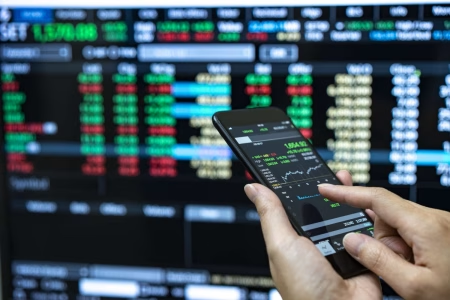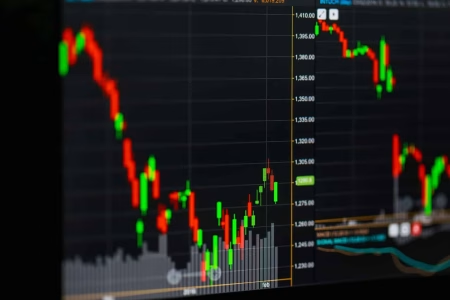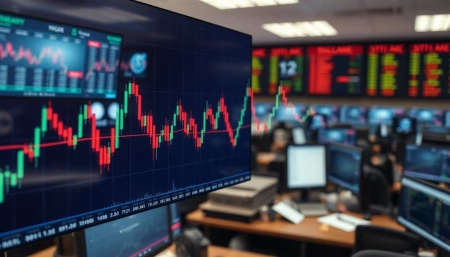Ever tried to sell something but couldn’t find a buyer? This is similar to the challenges of market liquidity in trading. Just like a seller’s problems when there are few buyers, financial markets face the same issues. Market liquidity is key to successful trading, helping you buy and sell assets smoothly.
Without understanding liquidity, making smart financial decisions is harder. In trading, being able to quickly buy or sell without big price changes is crucial. High liquidity means stable prices and fast trades, while low liquidity can lead to big price swings and extra costs.
As you learn more about trading, seeing how important liquidity is becomes clear. It shapes how you deal with the market and find chances to make money.
Key Takeaways
- Market liquidity refers to the ease of buying or selling assets without impacting prices.
- Low liquidity can cause price spikes, exemplified by rare high-demand items.
- Bid liquidity is the pool of buyers, while ask liquidity is the pool of sellers.
- Market liquidity is vital for a healthy trading environment, preventing volatility.
- The order book is essential for traders to make informed purchasing decisions.
- Liquidity is crucial for price stability and effective trade execution.
- Understanding liquidity levels can significantly affect your trading strategies.
Understanding Liquidity
Liquidity is key in finance, affecting how fast and easy assets can be traded. It shows how well you can turn assets into cash without big price changes. Knowing about liquidity helps investors and traders make better choices and keep markets stable.
Definition of Liquidity
The liquidity definition is about how fast you can buy or sell something at a fair price. Markets with lots of buyers and sellers are usually liquid, making trades quick. This is vital for day traders who need to act fast to make money.
On the other hand, low liquidity means prices can swing wildly and trades take longer. This makes trading harder.
Types of Liquidity
There are two main kinds of liquidity:
- Market Liquidity: This is about how well the whole market can handle buying and selling. It’s measured by how much is traded and the spread between bids and asks. Markets with lots of liquidity let people trade fast, which helps avoid big price swings.
- Asset Liquidity: This is about how easy it is to sell specific things. Cash is super liquid, meaning you can sell it right away. But things like real estate are less liquid because they take longer to sell and might sell for less.
Liquidity risk is a big worry in many areas. Investing in things that are hard to sell can make it tough to get your money back quickly. Knowing about liquidity helps you make smart trading plans, which is crucial in today’s fast markets.
| Asset Type | Liquidity Level |
|---|---|
| Cash | High |
| Stocks of Large Companies | High |
| Bonds | Medium |
| Real Estate | Low |
| Rare Artwork | Very Low |
The Importance of Market Liquidity in Trading
Market liquidity is key in trading. It affects how well you can trade and manage risks. Knowing its role helps you make better choices.
Impact on Trading Strategies
Good market liquidity means you can trade fast and cheap. This is great for day traders and scalpers. They can make more money because of lower costs.
But, if liquidity is low, trading gets harder. Spreads get wider, and prices can jump a lot. This makes it tough to trade well.
Market Efficiency
Liquidity makes markets efficient. When markets are liquid, prices change fast with new info. This keeps prices fair and true.
For example, big currency pairs like EUR/USD adjust quickly to news. This shows a liquid market is stable and trustworthy.
| Liquidity Type | Characteristics | Examples |
|---|---|---|
| High Liquidity | Minimal spread, quick execution, low volatility | Large-cap stocks (e.g., Apple, Microsoft) |
| Low Liquidity | Wider spread, delayed execution, high volatility | Small-cap stocks, exotic currency pairs (e.g., USD/TRY) |
Watching market liquidity helps you trade better. It leads to smarter decisions and better results. Understanding liquidity and your strategies is crucial for success.
What is Market Liquidity?
Understanding market liquidity is key to moving through the financial world. It means an asset, like a stock, can be bought or sold fast without big price changes. This quality helps buyers and sellers trade smoothly, making financial markets work better.
Definition and Explanation
Market liquidity is different from accounting liquidity. Accounting liquidity looks at how easily assets can turn into cash. Market liquidity is about quick trades at stable prices. Share turnover and bid-ask spreads show how liquid a stock is.
Publicly traded stocks are usually seen as liquid. This helps investors reach their financial goals.
Role in Financial Markets
Market liquidity is crucial for good trading volume. High liquidity means more trading, showing strong buyer and seller interest. This reduces the risk of liquidity problems.
In 2021, big stocks like Tesla, Amazon, and Apple had huge trading volumes. This high volume helps with individual trades and keeps the market stable.
Understanding market liquidity helps you make smart trading choices and manage risks. Knowing how it affects trading volume lets you handle market changes with confidence.
Measuring Market Liquidity
To understand market liquidity, we use key metrics and ratios. These tools help us see how easy it is to buy and sell assets. They also give us insights into trading conditions, which are crucial for our strategies.
Key Metrics and Ratios
There are several liquidity metrics that show how healthy the market is. Some important ones include:
- Bid-Ask Spread: This is the gap between the price to buy and sell. A smaller spread means more liquidity.
- Trading Volume: It shows how many shares or contracts are traded. High volume means it’s easier to trade without affecting prices too much.
- Liquidity Ratios: These ratios, like current and quick ratios, tell us if a company can pay its short-term debts. They help us understand a company’s liquidity.
Analyzing Trading Volume
Looking at trading volume gives us important information. When trading volume goes up, it means more people are interested in the market. This makes the market more liquid, allowing for smoother trading.
Recently, the U.S. Treasury securities market has shown great stability. With over $27 trillion in marketable debt, it supports high liquidity. This makes it easier for traders to buy and sell without big price changes.
As the market changes, watching trading volume and liquidity metrics helps us make better trading choices. These trends are key to understanding the stability of our trading plans.
| Metric | Significance | Recent Trend |
|---|---|---|
| Bid-Ask Spread | Narrower spreads indicate higher liquidity, allowing cheaper transactions. | Narrowed post-COVID-19, stable since mid-2023. |
| Trading Volume | High volume typically means lower price impact for trades. | General increase observed since March 2023. |
| Liquidity Ratios | Help assess a company’s ability to meet short-term obligations. | Ratios above 1 indicate healthy liquidity. |
Market Liquidity vs. Asset Liquidity
It’s important to know the difference between market liquidity and asset liquidity. Each one affects your investment choices and financial planning. Understanding these differences helps you see risks and chances in the financial world.
Comparison of Market and Accounting Liquidity
Market liquidity is about how easy it is to trade assets in markets. It’s about having buyers and sellers, making it easy to turn assets into cash quickly. Assets like cash and marketable securities are very liquid, making transactions fast.
But, assets like real estate are less liquid. They take longer to sell and might sell for less than expected.
Understanding Asset Liquidity
Looking at asset liquidity means checking the types of assets. Liquid assets are things like cash, cash equivalents, and money market accounts. Businesses use ratios like the quick ratio to check their liquidity.
When comparing liquidity, remember that market conditions can change. This can affect how easy it is to sell assets, leading to unexpected financial issues.
Factors Affecting Market Liquidity
Understanding what makes markets liquid is key for traders. Market depth and the order book are crucial. They show how well a market can handle trades without big price swings.
Market Depth and Order Book
Market depth is about the number of buy and sell orders at different prices. A deep market means big trades can happen without big price changes. A lot of buy and sell orders make trading smoother and safer.
A balanced order book shows a healthy market. It means prices are likely to stay stable. This is good for traders who want to buy or sell without big risks.
Influence of Trading Volume
Trading volume is a big factor in market liquidity. More trading means more people are involved, making markets more liquid. This can lead to tighter spreads and more stable prices.
Big events can change trading volume a lot. Economic news or global events can make markets busier. This shows how outside factors can affect how easy it is to trade.
| Factors | Impact on Market Liquidity |
|---|---|
| Market Depth | Indicates capacity for large trades; stability against price changes. |
| Order Book Dynamics | Reflects current market composition; balances supply and demand. |
| Trading Volume | Enhances liquidity; indicates market activity and participant engagement. |
| Macroeconomic Factors | Influences trading activity; affects participant behavior and sentiment. |
| Geopolitical Events | Can cause sudden liquidity shifts; impacts trading strategies. |
Knowing about market depth, order books, and trading volume helps traders. It lets them plan better and predict market moves.
How to Assess Market Liquidity Risk
In today’s fast-paced trading world, knowing how to check market liquidity risk is key. You need to spot issues that might slow down your trades or make them more expensive. This means looking at all the ways liquidity risks can affect your trading plans.
Identifying Liquidity Risks
Spotting liquidity risks means looking at several things that change how easy it is to sell an asset. Important signs include:
- Widening bid-ask spreads
- Decreasing trading volumes
- Changes in order book dynamics
Market liquidity shows how easy it is to turn an asset into cash without big losses. Think about the number of buyers and sellers, the size and frequency of trades, and how clear the market information is. These factors help you understand liquidity risks better.
Impact on Trading Decisions
Knowing about liquidity risks helps shape your trading choices. When markets are volatile or not very active, you might change your plans. For example:
- Opting for smaller positions
- Diversifying into more liquid assets
By managing liquidity risk well, you can keep your investment stable and safe from big losses. Doing a careful liquidity risk check is crucial for dealing with market ups and downs and getting good trading results.
What Are the Most Liquid Markets?
For traders and investors, knowing the most liquid markets is key. These markets are active, making trades fast and prices stable. They offer low costs and easy entry and exit points.
Characteristics of Highly Liquid Markets
Markets with high liquidity share some traits:
- High trading volumes show lots of activity.
- Many participants ensure a steady flow of buyers and sellers.
- Narrow bid-ask spreads cut down on costs.
- Trading happens all the time, making quick trades possible.
Popular Liquid Asset Classes
Several asset classes are known for their liquidity, making quick trades easy. These include:
| Asset Class | Description | Liquidity Level |
|---|---|---|
| Government Bonds | Standardized securities like U.S. Treasuries, widely recognized and traded. | High |
| Blue-Chip Stocks | Shares of reputable companies with a track record of reliability and financial performance. | High |
| Commodities | Physical goods like crude oil and gold with industrial demand and investment interest. | High |
| Cash and Cash Equivalents | Assets easily convertible to cash, including money market funds. | Very High |
| Marketable Securities | Stocks and bonds traded on exchanges, varying in liquidity based on duration. | Variable |
Trading well means knowing about liquid markets and using the best assets. Mixing liquid and less liquid assets can improve your portfolio. It helps make quick, smart decisions.
Impact of Liquidity on Bid-Ask Spread
It’s key to know how market liquidity affects the bid-ask spread for traders. The spread shows how liquid the market is. When there’s lots of liquidity, the spread gets smaller. This means lower costs for traders, as they can buy and sell closer to the same price.
Understanding Bid-Ask Spread
The bid-ask spread is the gap between what buyers and sellers want for an asset. A small spread means lots of trading and high liquidity. For example, currency trades often have spreads of just a hundredth of a percent.
On the other hand, less liquid assets, like small stocks, might have spreads of 1% to 2%. These differences show how liquidity affects trading costs.
Effects on Trading Costs
Wide bid-ask spreads can raise trading costs, especially in less liquid markets. This happens when there’s a big gap between supply and demand. Market makers help by adjusting prices based on the market and volume.
They work to keep the spread low, which lowers costs for traders. Market conditions, like time of day and volatility, also affect the spread. For example, private markets can have spreads of several percentage points, unlike public markets where popular stocks have narrower spreads.
Knowing about the bid-ask spread helps you cut down on trading costs. It’s important to understand what affects the spread, like liquidity. This knowledge helps you make better trading choices.
Challenges of Low Market Liquidity
Low market liquidity poses big challenges for investors and traders. It leads to high volatility and unexpected price changes. Even small trades can cause big price swings, making it hard to trade without big costs.
Risks of Trading in Illiquid Markets
The risks of trading in illiquid markets can scare off many. The price can move unpredictably. This makes trading risky.
- Price Risk: Low market liquidity can lead to significant price slippage when trying to execute a trade.
- Compliance Risk: Companies may face penalties if they cannot maintain liquidity ratios, impacting investors.
- Reputation Risk: Inability to trade effectively can harm a trader’s or company’s reputation in the marketplace.
- Default Risk: Illiquid assets can increase the likelihood of defaults during adverse conditions.
Trading in such environments requires smart risk management. This is to protect against financial losses.
Examples of Illiquid Assets
Investors should know about examples of illiquid assets that are hard to buy or sell. These include:
- Microcap stocks, which often see limited trading volumes.
- Certain real estate properties that may require extended periods to find suitable buyers.
- Collectibles like rare stamps or vintage coins that are not commonly traded.
Knowing these examples helps you understand the low market liquidity challenges. It prepares you for the unique risks of such investments.
Conclusion
Understanding market liquidity is key for good trading strategies and smart investments. High trading volume means investors are confident and the market is liquid. This makes it easy to buy and sell assets.
The bid-ask spread shows how liquid a market is. A smaller spread means lower costs and smoother trading. But, volatility can make markets less liquid by causing unpredictable price changes.
Having many market players helps make markets more liquid. For example, major forex pairs and big stocks have tight spreads and are stable. This makes trading easier and less costly.
But, trading in markets with few players is riskier. It can make your trading harder and hurt your returns. So, knowing about market liquidity is crucial in today’s fast-changing financial world.
By understanding market liquidity, you can make better trading choices. This helps you handle market challenges and find good opportunities.










